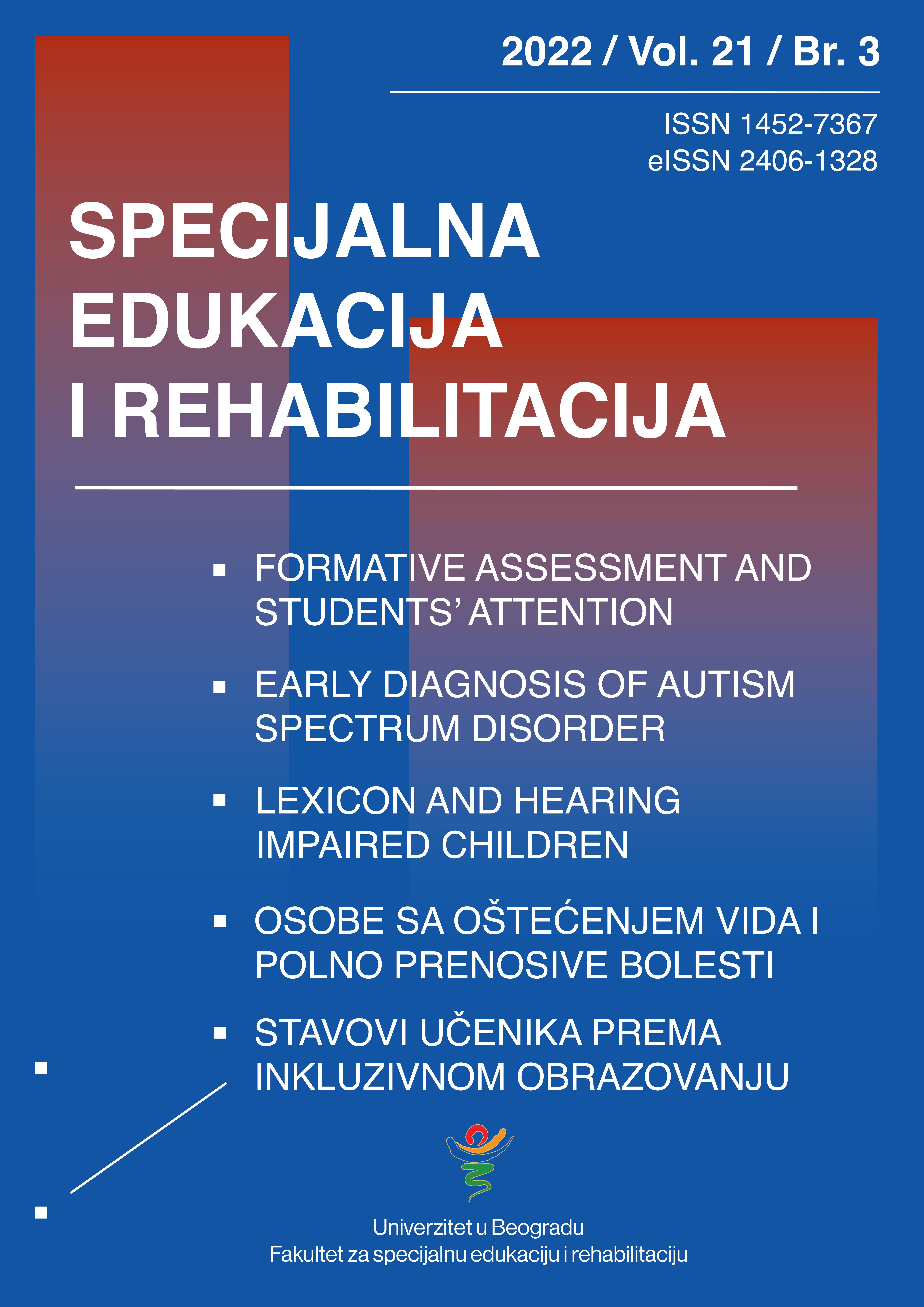The importance of early diagnosis of autism spectrum disorder for adequate treatment and rehabilitation in Macedonia
Abstract
Introduction. Autism spectrum disorder (ASD) has unclear etiology and no known universal treatment, making it difficult to obtain an accurate and timely diagnosis. The evidence that highlights the importance of early diagnosis and treatment is growing. Objective: The research was done to evaluate the impact of early diagnosis and its significance, as well as the effectiveness in obtaining the diagnosis in the past years and decades in Macedonia. Methods. We carried out a comparative analysis of the collected data from 95 subjects divided into three groups: 30 parents, 35 special educators and rehabilitators, and 30 members of the professional team that participated in diagnosing autism, using an original research tool in the form of three questionnaires. The data from the study refers to a research study conducted in Macedonia. Results. Many prenatal, perinatal, and postnatal factors can lead to ASD. The most common symptoms include: lack of speech, delayed speech for a specific age, not responding to their name, no eye contact, weak social skills, hyper/hyposensitivity, and isolation. Autism more frequently occurs isolated than accompanied by other conditions. The mean age of diagnosis used to be 5.6, while, in recent years, it has been 4.2. Children wait around 2.1 years from the first symptoms to obtain a diagnosis. Parents visit fewer institutions in the process of obtaining an ASD diagnosis. There is still a significant number of misdiagnoses. Conclusions. Many factors play a role in the occurrence of autism. There are a number of symptoms that appear in most cases. In the last decade, autism has been diagnosed earlier than before. The approach and process of diagnosing autism in Macedonia have improved.
References
Gabbay-Dizdar, N., Ilan, M., Meiri, G., Faroy, M., Michaelovski, A., Flusser, H., Menashe, I., Koller, J., Zachor, D. A., & Dinstein, I. (2021). Early diagnosis of autism in the community is associated with marked improvement in social symptoms within 1–2 years. Autism. Advance online publication. https://doi.org/10.1177/13623613211049011
King, M., & Bearman, P. (2009). Diagnostic change and the increased prevalence of autism. International Journal of Epidemiology, 38(5), 1224-1234. https://doi.org/10.1093/ije/dyp261
Lai, M.-C., Lombardo, M. V., & Baron-Cohen, S. (2014). Autism. The Lancet, 383(9920), 896-910. https://doi.org/10.1016/s0140-6736(13)61539-1
Parmeggiani, A., Corinaldesi, A., & Posar, A. (2019). Early features of autism spectrum disorder: A cross-sectional study. Italian Journal of Pediatrics, 45(1), Article 144. https://doi.org/10.1186/s13052-019-0733-8
Paula-Pérez, I., & Artigas-Pallarés, J. (2014). El autismo en el primer año [Autism in the first year]. Revista de Neurología, 58(S01), S117-S121. https://doi.org/10.33588/rn.58s01.2014016
Penner, M., Anagnostou, E., & Ungar, W. J. (2018). Practice patterns and determinants of wait time for autism spectrum disorder diagnosis in Canada. Molecular Autism, 9(1), Article 16. https://doi.org/10.1186/s13229-018-0201-0
Reichow, B., Hume, K., Barton, E. E., & Boyd, B. A. (2018). Early intensive behavioral intervention (EIBI) for young children with autism spectrum disorders (ASD). Cochrane Database of Systematic Reviews, 5(5), CD009260. https://doi.org/10.1002/14651858.cd009260.pub3
Remington, B., Hastings, R. P., Kovshoff, H., degli Espinosa, F., Jahr, E., Brown, T., Alsford, P., Lemaic, M., & Ward, N. (2007). Early intensive behavioral intervention: Outcomes for children with autism and their parents after two years. American Journal on Mental Retardation, 112(6), 418-438. https://doi.org/10.1352/0895-8017(2007)112[418:eibiof]2.0.co;2
Schilbach, L. (2022). Autism and other disorders of social interaction: Where we are and where to go from here. European Archives of Psychiatry and Clinical Neuroscience, 272(2), 173-175. https://doi.org/10.1007/s00406-022-01391-y
Trajkovski, V. (2017). Macedonia and autism. In F. Volkmar (Ed.), Encyclopedia of autism spectrum disorders. Springer. https://doi.org/10.1007/978-1-4614-6435-8_102172-1
Trajkovski, V. (2019). Health condition in persons with autism spectrum disorders. Journal for ReAttach Therapy and Developmental Diversities, 1(2), 112-124. https://doi.org/10.26407/2018jrtdd.1.12
Van’t Hof, M., Tisseur, C., van Berckelear-Onnes, I., van Nieuwenhuyzen, A., Daniels, A. M., Deen, M., Hoek, H. W., & Ester, W. A. (2020). Age at autism spectrum disorder diagnosis: A systematic review and meta-analysis from 2012 to 2019. Autism, 25(4), 862-873. https://doi.org/10.1177/1362361320971107
Wang, C., Geng, H., Liu, W., & Zhang, G. (2017). Prenatal, perinatal, and postnatal factors associated with autism. Medicine, 96(18), Article e6696. https://doi.org/10.1097/md.0000000000006696
Zachor, D. A., Ben-Itzchak, E., Rabinovich, A.-L., & Lahat, E. (2007). Change in autism core symptoms with intervention. Research in Autism Spectrum Disorders, 1(4), 304-317. https://doi.org/10.1016/j.rasd.2006.12.001
Copyright (c) 2022 Specijalna edukacija i rehabilitacija

This work is licensed under a Creative Commons Attribution-ShareAlike 4.0 International License.

